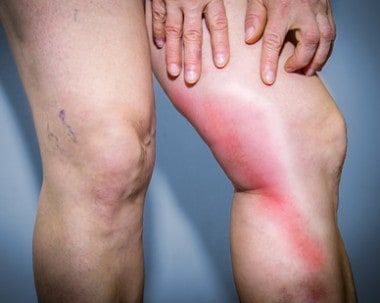Phlebitis and treatment by a vascular surgeon
A painful disease of superficial vessels is phlebitis. The cause is often varicose vein disease.
Inflammation often occurs during inpatient hospitalization when long-term cannulas are placed in the arm.
The medical term for this condition is thrombophlebitis. In individual cases, the painful inflammation can be accompanied by fever. This is a sign of the body’s defensive reaction.
In principle, thrombophlebitis is not a serious disease, but the healing process can extend over a period of several weeks if the course is unfavorable.
Recognize phlebitis at an early stage
The symptoms of phlebitis are easy to recognize. Severe pain in the affected areas is an unmistakable sign of the disease.
In addition, there is reddening of the skin and local heating on the corresponding area of skin. In most cases, phlebitis is accompanied by swelling of the vessels.
Since the veins are located just under the skin, the blood vessels can be felt under the skin.
Patients complain of severe pain when the inflamed area is subjected to mechanical stimuli. Muscle movements and touch are experienced as particularly unpleasant.
The classic symptoms of phlebitis often disappear after a few days. In individual cases, however, the recovery process can drag on for several weeks, which creates a high level of suffering for the affected person.
Treatment of phlebitis by the vascular surgeon
In most cases, phlebitis is caused by varicose veins. It is a dilatation of the veins in the extremities, resulting in a malfunction of the venous valves.
As a result, the blood can no longer be transported to the heart unhindered and becomes congested in the vessels. Water retention in the legs and swelling are not uncommon with severe varicose vein disease.
To fight the causes, you should treat the phlebitis at the vascular surgeon.
During varicose vein surgery the damaged blood vessels are removed. The return transport of the blood is taken over by other veins, so there is no need to worry about any adverse effects after the operation.
Medications and preparations for the treatment of phlebitis
Normally, phlebitis takes a mild course, since only the superficial blood vessels are affected. In this case, an anti-inflammatory ointment is applied to the affected areas.
Exercise therapy can be helpful, as it stimulates blood circulation in the body and supports the circulatory system.
Since affected persons suffer from severe pain, especially in the initial phase of thrombophlebitis, painkillers are often used, which are usually administered in tablet form.
The vascular surgeon may also prescribe anticoagulants if the consistency of the blood allows it.
